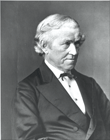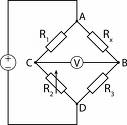Charles Wheatstone
- Birthdate
- 1802/02/02
- Birthplace
- Barnwood, UK
- Death date
- 1875/10/10
- Fields of study
- Telegraphy
Biography
Sir Charles Wheatstone was born on 2 February 1802 in the village of Barnwood in the United Kingdom. He was the second son of William Wheatstone, a manufacturer of musical instruments, and was taught in various schools throughout London. During his youth he would save money to purchase all types of book, including fairy tales, history and science. Wheatstone excelled in mathematics and physics, and learned French, Latin and Greek.
When he was 14 he was apprenticed to his uncle and namesake, also a maker and seller of musical instruments. Wheatstone took over his uncle’s musical business of manufacturing and sales at the age of 21. A prolific inventor, he also experimented with acoustics, optics, electricity and the telegraph. Wheatstone invented two new musical instruments, the Wheatstone Baritone English Concertina and the portable harmonium. The harmonium gained him a medal at the Great Exhibition in 1851.
However the invention that would forever be linked to Wheatstone is the Wheatstone Bridge. He publicly admitted that he did not invent it. But he did more than anyone else to advance its use when he enhanced and popularized the device in 1843.
The first description of the bridge was by Samuel Hunter Christie (1784-1865) and was published in the Philosophical Transactions in 1833. Christie designed the Bridge in order to be able to compare electromagnetic forces induced by magneto-electric induction in different metals. Wheatstone had been fascinated with electrical measurements, and worked on many devices for a number of years. He realized the Bridge could be used to compare resistances, and he put the necessary circuit into a board with terminals, thus producing the instrument we know today.
After the Bridge, Wheatstone’s most famous invention, with William F. Cooke, was one of the first practical telegraphs. Both gentlemen had been experimenting with telegraphs separately before they met. Cooke, after looking to Michael Faraday for advice on his telegraph, was directed to Wheatstone. In March 1837, the two agreed to form a partnership, as equal partners. They collaborated on the telegraph for several months and then applied for an English patent. They were allowed 6 months to come up with the specifications and after those were filed in December 1837, the patent was granted. However, the partnership was rocky and a dispute arose when Wheatstone decided that he had not been given enough credit for the invention. It was eventually determined that Wheatstone deserved the credit for the bulk of the scientific effort behind the telegraph, but Cooke was owed recognition for introducing it to the public. While Wheatstone’s work in telegraphy showed promise, in the long run, the Morse telegraph came to dominate the field.
There is evidence that Wheatstone preferred solitary work. In 1834 he was appointed as the Chair of Experimental Philosophy at Kings’ College, London, but he was very shy person and did not like to speak in public. He only lectured for one semester, then set out to do pure research for the remainder of his tenure at the College. His good friend Michael Faraday gave most of his lectures for him at the Royal Institution.
Wheatstone married late in life, at the age of 45, and he and his wife, Emma, raised five children. His nephew, Oliver Heaviside (1850-1925), also a pioneering electrical scientist, saw him as a mentor. Wheatstone encouraged Heaviside to study languages, for the same reason he did, to be able to read other’s papers. Wheatstone was Knighted in 1868 for his “great scientific attainments and of his valuable inventions.” He also received many other honors and degrees in recognition of his work. He never really retired, working until a few days before he died on 19 October 1875, while attending meetings at the Academy of Science in Paris.

